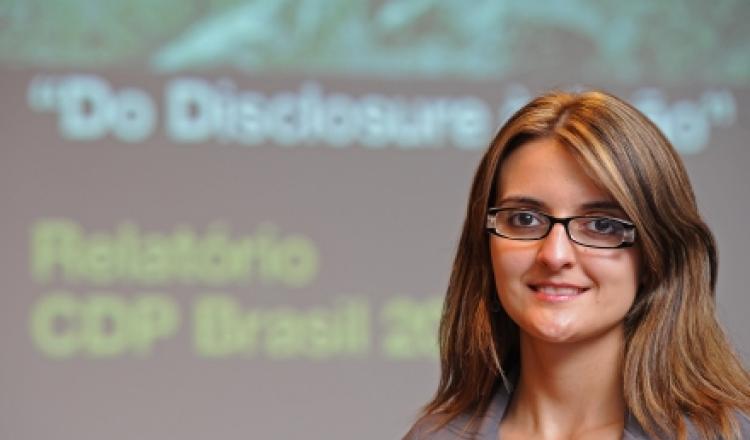Latin American companies that stand in emissions reporting challenge
ComunicaRSE interview Juliana Campos Lopes, Carbon Disclosure Project (CDP) Manager for Latin America, about the low participation of Latin American enterprises in CDP’s latest edition. Juliana Campos Lopes presents best practice in Brazil (Vale), Mexico (CEMEX) and Argentina (Banco Galicia). She remarks that voluntary carbon market remains strong and announces the implementation of Forest Footprint Disclosure Program and CDP Water Program in Latin America.
“More and more investors tie their financial objectives to social and environmental guidelines. Emissions reporting and Environmental, Social Governance information disclosure have become important factors for policies and investment decisions”.
“Latin America is a region with great conditions to meet this demand and became a leader in green innovations, given its natural wealth, resources and low emission path. Companies listed on international stock markets are committed to environmental reporting. However there is still much work to be done. The participation of companies in the CDP’s Latin American edition is lower (64%) than the response rate in the global edition (Global 500 list) that reached 81%”.
1. What are the main benefits and opportunities of emissions reporting?
"The exercise of reporting is meant to increase corporate awareness on energy efficiency and to exploit business opportunities. CDP information request, submitted on the form of a questionnaire, also functions as a plan of action on climate change that allows risk management and new opportunities associated with climate, which ensures business continuity in a long haul. In addition, companies respond to investors’ growing demand for Environmental information contributing to increase their reputation and access to new markets and/or sources of investment”.
2. Which countries stand on carbon management?
"Brazil, Mexico and Chile are the countries with the highest rates of responses to CDP. Brazil stands out for the significant participation of investors. Of 73 Latin American signatories, 68 are Brazilian. The other five signatories in Latin America are AFP Integra, Banco de Crédito del Perú, Banco Galicia, Banco Fira, Banco Banorte".
“I would like to highlights examples of best practice in Latin America”:
- "Vale mining company (Brazil) and its "Carbon Program": The program has reduction principles that establish a global target that want to reduce 5% of projected emissions, using a methodology similar to Brazilian National Climate Change Policy".
- "CEMEX (Mexico): In 2011 CEMEX achieved a 22.7% reduction in net CO2 emissions per ton of cement produced. Also in 2011 the rate of use of alternative fuels rose to 24.7% of the total fuel mixture, a considerable improvement over its rate of 20.3% in 2010".
- "Banco Galicia (Argentina) is known for having a Risk Management department, which reports directly to the Board of Directors of the Bank. Through an integrated financial, operational and credit risk management, Banco Galicia seeks to contribute to data transparency and market discipline. Environmental and social variables are identified as a dimension for risk assessment of clients. Since 2008, Banco Gaicia's social and environmental management was strengthened in accordance to the "Ecuador Principles", a risk management framework established by International Finance Corporation (IFC)".
3. Do you think Carbon Market "financial approach" is working as a tool to combat climate change?
"It should be noted that the mechanism of carbon bonds was created as an incentive against the establishment of emission limits. It can’t be seem only as a way to buy and sell emissions. Although guidelines for post-Kyoto period have not been defined, virtually paralyzing the emission regulated market, voluntary market remains strong. The great contribution of voluntary market is to have prompted many companies to look at the climate change issue through a lens of innovation, turning risk into business opportunities, considering the many examples of companies that have won new markets or reinvented their own business through efficient management of emissions. "
"Although we have not yet built a global regulation, through which all countries make their own climate change commitments, we have come a long way in defining indicators and methodologies for measuring and managing emissions through initiatives such as the GHG Protocol, CDP and the Carbon Disclosure Standards Board (CDSB).”
4. How could we reconcile the different positions between developed countries and developing economies in international forums on climate change?
"It is understandable and reasonable that the poorest countries charge developed nations for their emissions. However, emerging economies like Brazil, China, India, Russia and South Africa also have to take steps to reduce their emissions intensity. Technology transfer occurs only if someone actually pays for it. The Clean Development Mechanism (CDM) was a great way to achieve technology transfer, but the CDM market collapsed because a crisis demand".
Juliana Campos Lopes announced the implementation of Forest Footprint Disclosure program CDP and CDP Water program in Latin America:
"The two programs are begging in Latin America, but there are still few companies invited. In total, 14 companies were invited to answer information request on water (6 from Brazil, 4 from Mexico, 2 from Chile, 1 from Colombia and 1 from Peru) and 60 were invited to answer information request on forests. "
"In 2012, three Latin American companies replied to information request on water (CSN, Vale and Walmart Mexico) and 9 reported their data on the impacts on forests (Alsea of Mexico, Agrapalma, Arauco SA Curtume Viposa, Fibria, André Maggi Group, Grupo Bimbo, Marfrig and JBS). However it is important to continue encouraging companies and respondents to report to CDP. "
By María Julia Arana

